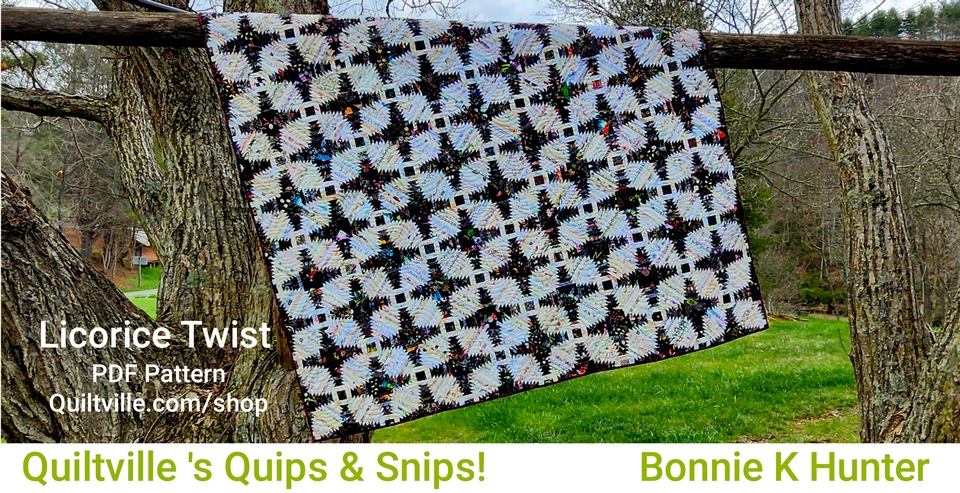(Click HERE for printer-friendly version)
After having SEW much fun with Hidden Spools, I went one step farther!
What if we divide one half of the quarter-block in the other direction??
Sept, 2005: This quilt donated to Hurricane Katrina Relief Efforts.
This traditional block pattern is known by many names. Barbara Brackman lists this block as being called 'wheel' in her encylcopedia of quilt block patterns and in block-base. Sew-Precise lists this block as 'blockade'
You can EASILY make this quilt with little fuss, and no cutting of individual pieces with this fun method!! Note: Construction of this quilt requires the use of the 6" Bias Square by That Patchwork Place.
Step #1: Dig into your scraps! You will need strips cut in 2 sizes: 2" and 3 1/2". Try to have a good variety of values from light to dark in each size.
I really used up some WEIRD stuff in this quilt! I must have been in an ugly fat quarter exchange or something, because there are fabrics with macaroni and vegtables, an ugly brown with HUGE white polka dots, and a bright pink with southwestern pots on it! What a collection! *hehehe* There is also a cowboy print with boots, hats, ropes,etc on a blue background. YUCK! But you know what? Cut up....it looks great!
You will end up with some odd looking lengths like this...but this is okay!
(in the case above, I would remove the blue, red and brown squares at right end of the picture.)
Step #6: Now the fun begins! Take this tube to your cutting board and lay it with the squares on top.
I got all these different 1/4 blocks from one tube-set!:
Step #7: Assemble the blocks! The blocks should be laid out like this:
When the blocks are sewn together....They will form pinwheels as a secondary design where the corners of the blocks come together. Look at the quilt at the top of the page again..can you find the hidden pinwheels?
Additional hints:
When working with bias edges ESPECIALLY..it is important that borders be applied correctly.
1. Measure the length of the quilt top..top to bottom.. through the center. Cut 2 side border strips to this
measurement, piecing strips if necessary. Mark the center point of each long side of the quilt top and the
center of the border strips with pins.
2. Pin the border to the quilt top, matching center marks and easing as necessary. Stitch in place, press
seams toward borders.
3. Measure the width of the quilt top through the center, this measurement will include the border just
added. Cut the top and bottom borders to this measurement, piecing strips as necessary.
4. Mark the center of the quilt top and bottom edge and the center of the borders with pins. Pin borders
to quilt, sew and press, as in step 2.
Problem: The quilt top is slightly longer than the border.
Solution: Sew with the quilt top on the bottom, when you put it through the sewing machine. Your sewing
machine’s feed dogs will help resolve the problem by easing in the excess fabric.

No comments:
Post a Comment
If you are commenting as "anonymous" please leave your name at the end of your comment.
Did you know that ad space on this blog provides for all of the free patterns and free mysteries and challenges at no cost to you? Without ads, this blog would not be possible.
Thank you for understanding the many hours that go into this blog 6 days a week, 52 weeks a year. :)